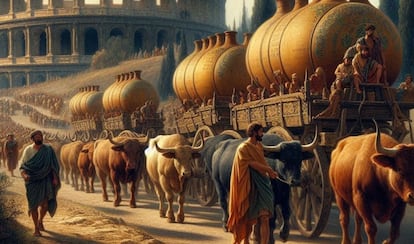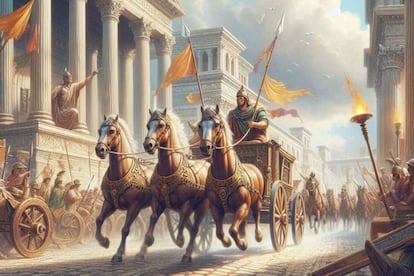The ‘cars’ of Roman antiquity: single, two-person and even primitive motorhomes
Historical research suggests high volumes of traffic in the cities of the ancient empire

Cars are not as modern as you might think. Humans have had the need to get around since time immemorial and, naturally, have always sought the most convenient way to do so. This has always been especially true for individuals belonging to the upper classes.
It turns out, even the Roman Empire had cars. Perhaps it’s a bit presumptuous to compare these wheeled machines with today’s gas and electric powered models. But it’s true: In ancient Rome, there were carriages, used for longer journeys, as well as other types of transport notable for catering to individual travel.
The first type of ‘personal vehicle’ used on a daily basis in ancient Rome was the litter, similar to the palanquin, but designed for travelling why lying down. The contraption consisted of a mattress supported on four legs, with two bars in front and two behind for carrying and moving the bed-mobile. The “engine,” in this case? Slaves, known as the lectiarii, or litter-carriers.

The person being transported would recline on the litter, his privacy protected with curtains enclosing the structure. After the litters came the basternas — a similar concept, but with a key difference: the person being transported would be seated.
Basternas, like litters, had no wheels, but were typically carried by two mules, one in front and one behind. A slave, called a basternarius, was in charge of directing the animals. These carriages were used on a daily basis across the Roman Empire.
Honking by shouting
Both of the vehicles had a very curious feature: horns. The usefulness of the device, still to this day an important safety feature of cars, was to warn passers-by to move aside as the litter or basterna made its way through crowded streets.
But in this case, the horn was a slave, who was in charge of announcing, loudly, that the person being transported was about to pass. Thus, people were warned to make way, and at the same time, riders could publicly perform their power and status, a common practice in ancient Rome.
Finally, for longer journeys, there were carriages for two or more people. These vehicles were equipped with wheels, without which it would have been very difficult to cover the long distances between the cities of the Empire.
From one side of the Empire to the other
There were various styles of ancient wheeled vehicles, or chariots, in Rome. The essedum was the lightest and was mainly used by messengers. The cisium and carpentum had more capacity and could even be used to spend the night, like a modern-day camper. Meanwhile, the plaustrum was mainly used for transporting goods.
Historical research suggests that the ancient cities of the Empire were clogged with traffic. Rome, in particular, was characterized by a large influx of vehicles, animals and pedestrians that crowded its streets — an early version of today’s congested city traffic.
These historic vehicles demonstrate that the need for daily mobility, and the need to cover long distances, is not just a modern-day phenomenon. Using donkeys, enslaved humans, internal combustion engines or electricity, people have always sought out the most comfortable and efficient way to reach their destination.
Sign up for our weekly newsletter to get more English-language news coverage from EL PAÍS USA Edition
Tu suscripción se está usando en otro dispositivo
¿Quieres añadir otro usuario a tu suscripción?
Si continúas leyendo en este dispositivo, no se podrá leer en el otro.
FlechaTu suscripción se está usando en otro dispositivo y solo puedes acceder a EL PAÍS desde un dispositivo a la vez.
Si quieres compartir tu cuenta, cambia tu suscripción a la modalidad Premium, así podrás añadir otro usuario. Cada uno accederá con su propia cuenta de email, lo que os permitirá personalizar vuestra experiencia en EL PAÍS.
¿Tienes una suscripción de empresa? Accede aquí para contratar más cuentas.
En el caso de no saber quién está usando tu cuenta, te recomendamos cambiar tu contraseña aquí.
Si decides continuar compartiendo tu cuenta, este mensaje se mostrará en tu dispositivo y en el de la otra persona que está usando tu cuenta de forma indefinida, afectando a tu experiencia de lectura. Puedes consultar aquí los términos y condiciones de la suscripción digital.
More information
Últimas noticias
Most viewed
- Sinaloa Cartel war is taking its toll on Los Chapitos
- Oona Chaplin: ‘I told James Cameron that I was living in a treehouse and starting a permaculture project with a friend’
- Reinhard Genzel, Nobel laureate in physics: ‘One-minute videos will never give you the truth’
- Why the price of coffee has skyrocketed: from Brazilian plantations to specialty coffee houses
- Silver prices are going crazy: This is what’s fueling the rally










































